book1unit4Earthquake教案
Unit4_Earthquake 教案(新人教版必修1)
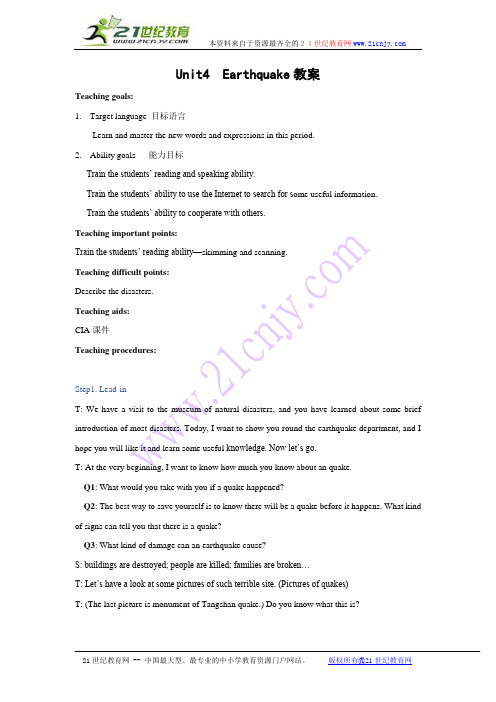
Unit4 Earthquake教案Teaching goals:1.Target language 目标语言Learn and master the new words and expressions in this period.2.Ability goals 能力目标Train the students’ reading and speaking ability.Train the students’ ability to use the Internet to search for s ome useful information.Train the students’ ability to cooperate with others.Teaching important points:Train the students’ reading ability—skimming and scanning.Teaching difficult points:Describe the disasters.Teaching aids:CIA课件Teaching procedures:Step1. Lead-inT: We have a visit to the museum of natural disasters, and you have learned about some brief introduction of most disasters. Today, I want to show you round the earthquake department, and I hope you will like it and learn some useful knowledge. Now let’s go.T: At the very beginning, I want to know how much you know about an quake.Q1: What would you take with you if a quake happened?Q2: The best way to save yourself is to know there will be a quake before it happens. What kind of signs can tell you that there is a quake?Q3: What kind of damage can an earthquake cause?S: buildings are destroyed; people are killed; families are broken…T: Let’s have a look at some pictures of such terrible site. (Pictures of quakes)T: (The last picture is monument of Tangshan quake.) Do you know what this is?Step2. Pre-ReadingT: 30 years ago, on the day July, the 28th, a terrible disaster suddenly happened, and the beautiful Tangshan was removed from the map. This is Tangshan quake. Does any body know something about Tangshan quake?T: Let’s read a news report about the famous quake.Step3. While-readingI. Skimming & scaringGet the students comprehend the passage quickly and accurately, and meanwhile help the students to form a good habit of reading.T: First please skim the passage fast to obtain/ get a general understanding of the whole passage. And underline the answers to the following questions.1.When did the quake happen? (Why did the writer use different expression of the samething?)2.How many people were killed and injured during the quake?3.How many buildings were destroyed?II. While reading, divide the whole passage into 3parts and find out the main idea of each part. Para.1 before the quakePara.2-3 during the quakePara.4 after the quakeII. Careful-readingRead the passage again and try to get more detailed information.T: Now let’s read the passage again and find more information. Join the correct parts of the sentences. (Turn to page 27, ex1)T: Now you have read the passage carefully, please put the sentences in order. Number each of these things during the Tangshan quake.(Turn to page 27, ex2)T: here are some more work for you. You can work in groups.1.What strange things happened before the quake?2.What sentences can express the quake is GREAT?3.What numbers can express the quake is GREAT?4.What metaphor does the writer use to say the quake is GREAT?5.What happened when rescue work was going on?6.How did the army help to rescue survivors?T: Let’s watch some pictures, and comparing the old Tangshan, the Tangshan after quake, and the new Tang Shan we see today.Step 4 Post-reading (discussing)T: After read the news report, and see so many pictures, what impresses you most? Why?Or what do you learn from such a disaster?(Self-rescue, environment protection, rebuilt, love and help)I: self-rescue (a video game)T: When in a quake, if you know some self-rescue skills, you may probably save yourself. If you want to know some of the skills, click here. (Link to the index)Let’s do little game to see how much you know about self-rescue.II. What did they suffer and feel?T: Can you understand what they suffer and what they feel after such a disaster?T: If you were one of the rescuers 30 years ago, what could you say and what can you do to comfort them? Or how could you help them?III. RebuildingT: we see that the new Tangshan has been set up. What is needed to rebuild Tangshan.IV: environment protectionT: nowadays there are more disasters than before. One of the reasons is that we pay more attention to our economy development than the earth we live.Look at these pictures. What can we students do to save the earth?T: Though the disasters destroy buildings, people’s lives, but it can n ot destroy the love among us.Step 5 Homework1.Find more news reports about earthquake.2.Write a piece of news about Tangshan. You can use the information in the passage.Warming up by discussingNow, look at the pictures of Tangshan and San Francisco in warming up and describewhat you see in the pictures. (beautiful cities; broad roads; tall building; large population.)What will happen if there has been a big earthquake in these two cities?As we all know, earthquakes are disasters to everyone. But can we avoid or at least reduce the loss caused by earthquakes? Can we foretell earthquakes? Now let’s come to Pre-reading and decide what may happen before an earthquake comes.II. Pre-reading1.Talking and sharingWhat are the signs of an earthquake? (e.g. Cows, pigs and dogs become too nervous too eat. The mice will run out of the fields looking for places to hide. The water in the wells will rise and fall. Walls of the wells in village will have deep cracks. There will be bright light in the sky….)2. Imaging and sharingImagine there is an earthquake now, your home begins to shake and you must leave it right away. You have time to take only one thing. What will you take? Why?III. Reading1. Listening and fast readingNow let’s come to the text “A NIGHT THE EARTH DIDN’T SLEEP” and see what it tells us. Please listen to the text and get the general idea of the passage. You should pay attention to the first sentences of each paragraph. In what order is the text written? (The text is written in time order. The general idea is the mixture of the first sentences of each paragraph, that is, the text tells us something that happened before the earthquake, during the earthquake and after the earthquake.)2. Reading and underliningNext you are to read and underline all the useful expressions or collocations in the passage. Copy them in your notebook after class as homework.Collocations from A NIGHT THE EARTH DIDN’T SLEEPa smelly gas, come out of, in the farmyards, too nervous to eat, run out of, lookfor place to hide, water pipes, think little of sth., as usual, it seemed that, at anend, one hundred kilometers away, one-third, eight kilometers long, thirty meters wide, cut across, in ruins, be injury, the number of, reach more than 400, 000, everywhere, everything was destroyed, be gone, blow away, sth. be not safe for, thousands of, give milk, half a million, instead of, be shocked, later that afternoon,be trapped under the ruins, fall down, all…is/was not…,hundreds of thousands of,dig out, the dead, to the north of, coal mines, built shelters, fresh water3. Reading aloud and translatingNext we are going to read aloud the text and translate it into Chinese.4. Reading and transforming informationRead the text again and answer the following questions.1. What natural signs of coming disaster were there?2. Can you think of some reasons why these signs weren’t noticed?3. Can you describe the disaster caused by the earthquake?4. What events and situations probably made the disaster worse?5. How were the survivors helped?6. Could anything more have been done to help the survivors? Why or why not? Answers: 1, 3, 4, 5 are easy to answer.2. Maybe at that time people didn’t have knowledge of an earthquake.6. The students have their own answers.4. Discussing writing styleAs you have understood the general idea of the text, I still put more questions to you.1.From whose point of view are events described? How do you know? (A writer who didn’t see the quake uses the third person “they” when he wri tes.)2.Why do you think the writer chose to express her feelings about the quake rather than simply report what happened? (Although the writer was not there he felt sad for the people of Tang Shan. He knows that giving some feelings will make the reading more interesting.)3.Why is the title “A NIGHT THE EARTH D I DN’T SLEEP”? (As usual, night is thetime to sleep, and night should be quiet and safe. But that night everything changed. The writer used it as a title to show how terrible and how unusual that night is.)5. Reading and understanding difficult sentences.If you have some difficult sentences to understand, come to me for help.IV. Closing downClosing down by doing exercisesNow please do the comprehending Exercises 1, 2 and 3 on page 27.Closing down by discussingBy now you’ve known that earthquakes are terrible natural disasters and that China is unlucky enough to have a lot of them. Now imagine that your group lives in the city that has a lot of earthquakes, what should you do during an earthquake? Look at the given situation and discuss in pairs.(1) If you are OUTDOORS, …(2) If you are in a HIGH BUILDING, …(3) If you are DRIVING, …(4) If you are HAVING CLASS, …(5) If you are in a CINEMA, …What should you do during the earthquake?Situation:(1) how to rescue those still trapped in the ruins;(2) how to take care of the survivors;(3) how to repair buildings that survived the earthquake;(4) what to do with the buildings that survived the earthquake;(5) where to find people to help build a new city;(6) how to teach children about earthquake safety;(7) where to put information for survivors and their families;(8) how to plan for further disasters.Period 2: A sample lesson plan for Learning about Language(The Attributive Clause: that, which, who, whose)AimsTo learn about the usage of who, which, that and whose in the Attributive ClauseTo discover useful words and expressionsProceduresI. Warming upWarming up by discovering useful words and expressionsHello everyone. After reading the passage, we have got to know the usage of the words and expressions, but we should do more practice. Now turn to page 27 to find the correct words and expressions from the passage to finish the sentences. You are given two minutes to finish them. Of course, you can discuss with your partners. Two minutes later, check in pairs and then check with the whole class.II. Learning about language1. Reading and findingTurn to page 26 and read the text A NIGHT THE EARTH DIDN’T SLEEP. Tick out the attributive clauses in the reading passage and translate them into Chinese.2. Doing Exercises 2 on page 28Turn to page 28 and do Exercise 2 in pairs.III. Ready used materials for Relative Pronouns: which, that, who whom whoseWhat are Relative Pronouns?Relative pronouns are special pronouns which can connect the antecedent and theattributive clause. Also they can be used as a part of the attributive clause. Here are some important differences:1.w hich/ that: referring to things, can be used as a subject or an object in the attributive clause; when they are used as an object, they can be omitted:The plane is a machine that/which can fly.The school (that/which) he visited last week is to the south of the city.2.that/ who/whom: referring to a person, can be used as subject or object in the attributive clause; whom can be used as an object:The girl (that/whom/who) we saw yesterday was Jim’s sister.The man that/who is talking to my father is my maths teacher.3. whose: referring to a person or a thing, can be used as an attribute in the attributive clause:This is the writer whose name is known all over the world.The room whose window faces south is mine.4.Before everything, anything, everybody, anybody, all, the best +n, thefifth +n, we use that instead of which:All (that) I need is time.This is the largest factory (that) I have ever visitedThe sixth lesson (that) we are learning is the most difficult in Book Two.5. We can’t use that in a Non-Defining Attributive Clause:I have lost the pen, which I like very much.I have two sisters, who are both teachers.IV. Closing down by doing a quizNow you are going to take a quiz on Relative Pronouns.Fill in the blanks, using which, that, who, whom, whose.(1) The force ( ) causes everything to fall towards the ground is called gravity.(2) A friend ( ) helps you in time of need is a friend indeed.(3) Do you know the girl ( ) parents are teachers in our school?(4)The woman ( ) I spoke to just now is my English teacher.(5) He saw a house ( ) windows were all broken.(6)Everything ( ) can be done today mustn’t be done tomorrow.(7)Can you think of anyone ( ) could look after him?(8)This is the best hotel ( ) I know.(9)The man ( ) I saw told me to come back today.(10)Those ( ) want to go to the Great Wall write down your names here.(11) He talked a lot about the teachers and the schools ( ) he had visited.(12)The ninth lesson ( ) we are learning is the most difficult in Book One.(13)Mount Blanc(勃朗峰), ( ) they visited last month, is the highest mountain in(14)We know all the teacher ( ) work in our school.(15)The house in ( ) Lu Xun once lived is a museum now.(16)The house ( ) Lu Xun once lived is a museum now.(17)The house ( ) Lu Xun once lived in is a museum now.(18)You can take any room ( ) you like.(19) He showed a machine ( ) parts are too small to be seen.(20)The sports meet was put off, ( ) was exactly what we wanted.Answers to the exercises: (1)which/that (2)who/that (3)whose (4)whom/that/who (5)w (6)that (7)that (8)that (9)that/whom/who (10)who (11)that (12)that (13)which (1 (15)which (16)in which/where (17)which/that (18)that (19)whose (20)whichPeriod 3:A sample lesson plan for Using Language(A letter from Zhang Sha)AimsTo read and speak about travelingTo write a letter describing feeling about travelingProceduresI. Warming upWarming up by discussingHave you ever written a speech? What is a speech? Speech means an act of speaking formally to a group of listeners. What do you have to consider when you are writing a speech? Please discuss it in pairs. (1. Who is the audience? 2. How can we express ourselves clearly?)Warming up by readingWhat should you include in your speech when you try to write one? Read the letter on page 29 and imagine you are the student who was invited to give a speech. Now write a short speech, in which you should follow the points in exercise 3 on page 29.II. Reading and underliningRead the letter and exercises again and underline all the useful expressions or collocations in the letter. Copy them in your notebook after class as homework.Collocations from the lettercongratulations, be pleased to do sth., win the high school speaking competition, a group of five judges, all of whom, agree, be proud of, open a new park, honour those wh died in the terrible disaster, would like to do, have you do sth., as you know, invite sb.to do sth., on that special day, at the beginning of, thank sb, for doing sth.,honour sb. for sth., be known as, encourage sb. to do sth., be happy to do sth.,collect stamps, lose one’s lifeIII. ListeningTurn on your books at page 30. We’ll listen to a story about a person who experienced the 1906 S an Francisco earthquake. I’ll play the tape three times. First listen and try to get some details that exercises 1 and 2 request. Second listen again and try to finish the exercises. Third listen and check your answers.IV. Guided writing (SB. page 31)1. Making a introductionHave you ever read a newspaper story? Now turn on your books to page 31 and look at Writing.Read the brief description about how to write a newspaper story. Compare a newspaper story to a short story and answer the following questions.1) What should you write before writing a newspaper story? (outline)2) What should a newspaper outline have? (a headline; a list of main ideas; a list of important details)3) Why a headline is needed? (It can tell the readers what the topic is; it can also attract the readers’ attention)4) How can you finish a newspaper story? (First, you should write a headline, then organize your main ideas into paragraphs, and then put some details into each paragraph.)5) Have you found out the difference between a newspaper story and a short story? (Usually a short story begins with small details and includes big details later. A newspaper story does just the opposite. Both kinds of stories use paragraphs with main ideas. In a good newspaper story, the point-of-view is objective (i.e. it has no point-of-view) while a short story is subjective (i.e. it has a point-of-view). A newspaper story has no conclusion; a short story generally does.)Now I’ll show you a newspaper story to find out the headline, main idea and details of each paragraph.THE WASHINGTON POSTSEATTLE-A powerful earthquake with a magnitude of 6.8 hit Washington State last week. The quake, the biggest in 50 years, caused billions of dollars in damage. But miraculously, only one person died and more than 100 people were injured in the quake.Authorities said one reason there wasn’t greater destruction is that the region spent millions of dollars in the last decade designing earthquake----proof facilities and improving existingbuildings, schools and homes.Earthquake expert said the event illustrated(说明) the growing gap between rich and poor nations in the ability to mitigate(减轻) natural disasters. Only a handful of people were seriously injured here, a slight number compared with the devastation(破坏) in countries like Turkey, India and El Salvador, where quakes have buried thousands under poorly constructed buildings.2. WritingNow prepare the outline for a short newspaper story for China Daily. You can use the example in exercise 1 to help you organize your outline.3. Underlingoutline and the newspaper story in Writing and underline allor collocations in them. Copy them to your notebook afterCollocations from Writinga list of, put some details into each paragraph, a team of, raise money, thousands of, plan to do sth., in early June, hope to do sth., be interested to do sth.IV. Closing DownClosing down by summaryWe have learned a lot about earthquakes. Now let’s have a summary about what we haveLook at the following questions.(1) Have you ever experienced an earthquake?(2) Can you describe an earthquake in English?(3) What do you know about the cause of an earthquake?(4) What new information about earthquakes have you learned now?(5) What words and expressions can you use to describe an earthquake?Closing down by finding informationGo to the library to read or get online to search in order to find more in formation about naturaldisasters.Part Two: Teaching Resources (第二部分:教学资源)Section1: A text structure analysis of A NIGHT THE EARTH DIDN’T SLEEPI. Type of writing and summary of the main ideaType of writing This is a piece of descriptive writingMain idea of the passage The article describes the cause, the course and theresult of Tang Shan earthquake in 1976. Itshows us the terrible image of earthquake. At thesame time it hits us that we must realize thatwe can do something to minimize the damagecaused by earthquake.Topic sentence of 1st paragraph Strange things were happening in the countryside innortheast Hebei.Topic sentence of 2nd paragraph Everything began to shake and it seemed that theworld was at an end.Topic sentence of 3rd paragraph Everywhere they looked nearly everything wasdestroyed.Topic sentence of 4th paragraph All hope was not lost.II. A text structure analysisRead the text “A NIGHT THE EARTH DIDN’T SLEEP”, and then complete the following chart.Time/ order What happened Resultthree days before the earthquake Saw: crackswater in the wells--- rose and fell,animals--- too nervous , hidefish jumped out of bowls & pondsPeople thought little of theevents and went to bedas usualat about 3:00 ambright light in the skywater pipes---cracked and burst heard: sound of planessmelt: smelly gas in the cracks of the wellsat 3:42 am felt: everything shookone-third nation felt itheard in Beijing 100 kilometers awaya huge crack cut across houses,roads…saw: steam burst from holes in the groundhard hills of rock-rivers of dirtcity lay in ruins4 400,000 peoplekilled/injured75% factories90% home were gonebricks covereddams/bridges fellnot safe railway tracksuselesscows never milkpigs/chickens diedwells filled with sandrescue workers andtrapped under the ruinsbuildings fell downwater/food/electricityhard to getafter that hope not lostarmy sent 150,000 soldiersworkers built shelters for survivorsfresh water was taken to the citythe city began to breathe again。
人教版高中英语必修第一册 《Unit 4:Earthquakes》教案

人教版高中英语必修第一册 《Unit 4:Earthquakes》教案一、教学目标1.知识目标o学生能够掌握与地震相关的重点词汇和短语,如 “earthquake, ruin, destroy, rescue, shock” 等。
o学生能够理解并运用描述地震现象、危害和救援的句型和表达方式。
2.技能目标o学生能够听懂有关地震的简单对话和新闻报道,获取关键信息。
o学生能够阅读并理解关于地震的文章,分析文章结构和主旨。
o学生能够用英语简单讲述地震的相关知识和个人应对地震的措施。
o学生能够写一篇关于地震预防或救援的短文,表达自己的观点和建议。
3.情感目标o培养学生对自然灾害的认识和防范意识。
o激发学生的同情心和社会责任感,关注地震受灾地区和人群。
二、教学重难点1.教学重点o重点词汇和短语的记忆与运用。
o对课文中地震相关内容的理解和语言表达的学习。
o培养学生用英语描述地震和表达应对措施的能力。
2.教学难点o如何帮助学生理解地震的复杂科学原理和巨大危害,并能用英语进行准确描述。
o引导学生在写作中清晰、有条理地阐述地震预防或救援的观点和建议。
三、教学方法1.直观演示法:通过图片、视频等展示地震的场景和数据。
2.问题引导法:以问题为导向,引导学生思考和探究。
3.讨论交流法:组织学生讨论地震相关话题,促进学生之间的思想交流。
四、教学过程(一)导入(5 分钟)1.播放一段地震的视频片段,展示地震的破坏力。
2.提问学生:What do you see in the video? How do you feel about earthquakes?(二)词汇学习(10 分钟)1.呈现本单元的重点词汇和短语,结合地震的情景进行讲解。
2.通过词汇练习,如填空、选择等,巩固学生对词汇的理解和掌握。
(三)阅读前准备(5 分钟)1.让学生观察课文标题和图片,预测文章的主要内容。
2.提出一些引导性问题,如:What might the article talk about earthquakes?(四)课文阅读(15 分钟)1.学生快速阅读课文,概括文章的主旨。
人教版高中英语必修1教案Unit 4 Earthquakes
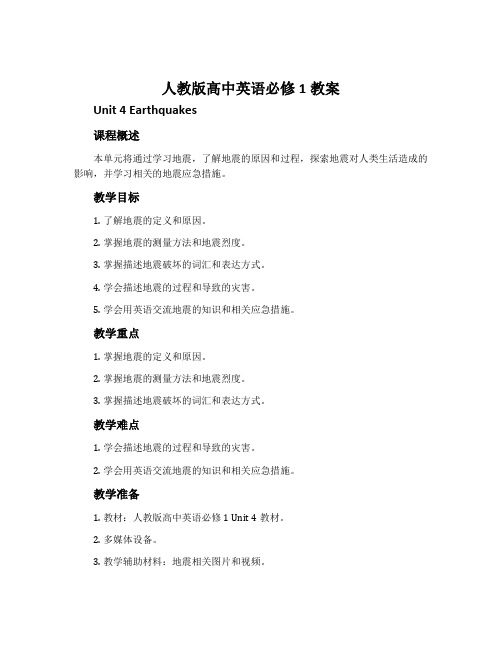
人教版高中英语必修1教案Unit 4 Earthquakes课程概述本单元将通过学习地震,了解地震的原因和过程,探索地震对人类生活造成的影响,并学习相关的地震应急措施。
教学目标1.了解地震的定义和原因。
2.掌握地震的测量方法和地震烈度。
3.掌握描述地震破坏的词汇和表达方式。
4.学会描述地震的过程和导致的灾害。
5.学会用英语交流地震的知识和相关应急措施。
教学重点1.掌握地震的定义和原因。
2.掌握地震的测量方法和地震烈度。
3.掌握描述地震破坏的词汇和表达方式。
教学难点1.学会描述地震的过程和导致的灾害。
2.学会用英语交流地震的知识和相关应急措施。
教学准备1.教材:人教版高中英语必修1 Unit 4教材。
2.多媒体设备。
3.教学辅助材料:地震相关图片和视频。
教学过程Step 1:导入引入地震话题,通过展示一些地震相关的图片和视频,激发学生对地震的兴趣。
Step 2:预习导入让学生回顾并回答上一课程的问题,复习地震的原因和地震烈度的概念。
Step 3:新课讲解1.引入新课程,并解释地震的定义和原因。
2.分析地震测量方法和地震烈度的概念。
3.教授描述地震破坏的词汇和表达方式。
Step 4:课堂练习1.教师提供一些描述地震破坏的情景,让学生用英语描述。
2.分组讨论地震破坏的方式和后果,并用英语呈现自己的讨论结果。
Step 5:拓展阅读教师提供一篇有关地震的拓展阅读材料,让学生阅读并回答相关问题,扩展学生对地震的了解和地震相关词汇的应用。
Step 6:小组活动学生分组进行小组讨论和设计,就地震应急措施展开讨论,并用英语准备一份小组演讲。
Step 7:总结与评价教师进行本节课的知识总结,并对学生的表现进行评价和鼓励。
课后作业1.整理地震相关知识,写一篇300字的地震科普文章。
2.阅读教材中的相关练习,完成练习题。
总结通过本课程的学习,学生将掌握地震的基本知识和相关词汇,能够描述地震的过程和导致的灾害,并能用英语交流地震的知识和应急措施。
高一英语必修一Unit-4-earthquakes的阅读公开课课教案

Unit 4 EartquakesYuan XiaoshaTitle: Book1 Unit 4 Earthquakes --- ReadingTarget students: Senior 1Teacher: Yuan XiaoshaTeaching aimsKnowledge aims:1. Enable the students to memorize useful expressions.2. Enable the students to know what to do in an earthquake..Ability aims:1. To train and improve students’ ability to read a passage.2. To improve students’ability to express their own ideas by asking and answering questions.Emotional aims:1. To make the students never lost hope in daily life.2. To develop their habit in helping others.Key and important points :eful expressions(injury, in ruins…)2.How to help students to improve reading skills.Teaching methods:Task-based approach &. Communicative teaching method学情分析及前期预测:高一学生,刚军训完一个月,英语水平总体差距较大,其水平分布呈以下特点:分化情况较明显,学生之间的水平差距较大;学生虽然对英语感兴趣,但学习主动性还有待加强;部分学生对教师的依懒性较强,未能主动通过多种渠道获取信息。
高中英语_Book 1 unit 4 Earthquakes教学设计学情分析教材分析课后反思
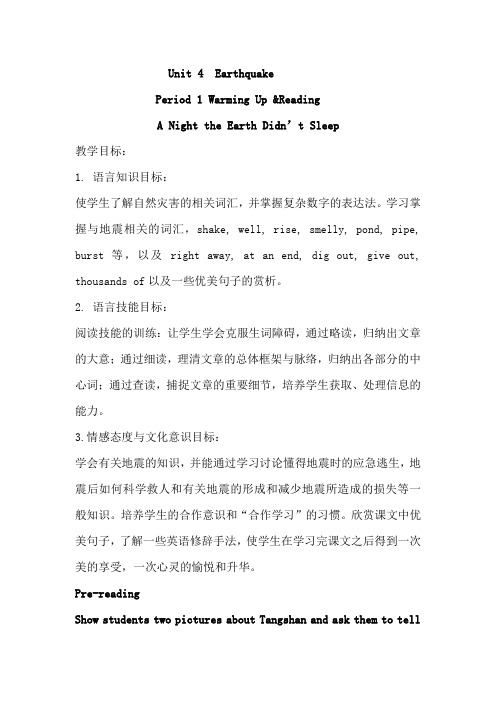
Unit 4 EarthquakePeriod 1 Warming Up &ReadingA Night the Earth Didn’t Sleep教学目标:1. 语言知识目标:使学生了解自然灾害的相关词汇,并掌握复杂数字的表达法。
学习掌握与地震相关的词汇,shake, well, rise, smelly, pond, pipe, burst等,以及right away, at an end, dig out, give out, thousands of以及一些优美句子的赏析。
2. 语言技能目标:阅读技能的训练:让学生学会克服生词障碍,通过略读,归纳出文章的大意;通过细读,理清文章的总体框架与脉络,归纳出各部分的中心词;通过查读,捕捉文章的重要细节,培养学生获取、处理信息的能力。
3.情感态度与文化意识目标:学会有关地震的知识,并能通过学习讨论懂得地震时的应急逃生,地震后如何科学救人和有关地震的形成和减少地震所造成的损失等一般知识。
培养学生的合作意识和“合作学习”的习惯。
欣赏课文中优美句子,了解一些英语修辞手法,使学生在学习完课文之后得到一次美的享受,一次心灵的愉悦和升华。
Pre-readingShow students two pictures about Tangshan and ask them to tellthe differences .Fast readingRead the passage and decide where this passage is taken from ____A.Medical book B. newspaperC. A magazine bookD. a science bookskimmingFind out the topic sentence of each paragraph. (The topic sentence states the main idea of the paragraph , usually at the beginning)Read the text again and find out the topic sentence of each paragraph and then divide the whole text into three parts according to the time.Paragraph 1Paragraph 2Paragraph 3Paragraph 4Careful readingPart1 before the earthquakeDescribe the signs of the earthquakePart2 during the earthquake Para 2&31.What suffered damage in the earthquake?A.human livesB.constructions (建筑物) (houses, roads, hospitals, factories, buildings and so on)C.animal livesD.All of the aboveRead and find the related information .one-third One-third of the nation ____it.15 seconds In 15 seconds the city __________two-thirds Two-thirds ____or were______.400,000 400,000 people were_____________75% 75% of its factories were _____90% 90% of its homes __________Two Two dams and most bridges _____What can you learn from the numbers?Part3 after the earthquakeIn order to creat a vivid(生动的) image of the damage the writer uses rhetoric devices(修辞手法),such as exaggeration(夸张) and simile(比喻).My blood freeze. exaggeration(夸张)The girl is like a flower. simile(比喻)Answer the following questions according to paragraph 4: 1.All hope was not lost.2.What did the army do?3.What did the workers do?4.What does the sentence “Slowly, the city began to breathe again”mean?A.People who were trapped came to lifeB.The trees turned green.C.The animals began to breathe.D.The city returned to normal gradually.Further understandingWhy does the writer use “A night the earth didn’t sleep” as the title?In pairs, suggest another title for the text.DiscussionWhat shall we do if an earthqua happensespecially when we are having a class?学情分析学习的对象是处于城乡结合部的高一学生,他们的英语基础较差,特别是由于词汇量缺乏,阅读习惯不好,导致阅读速度慢、阅读理解能力差。
高中英语人教版必修一Unit4Earthquakes单元教案
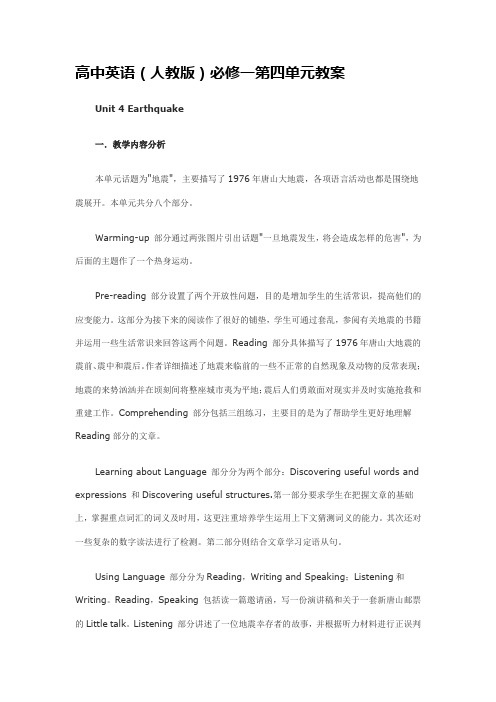
高中英语(人教版)必修一第四单元教案Unit 4 Earthquake一.教学内容分析本单元话题为"地震",主要描写了1976年唐山大地震,各项语言活动也都是围绕地震展开。
本单元共分八个部分。
Warming-up 部分通过两张图片引出话题"一旦地震发生,将会造成怎样的危害",为后面的主题作了一个热身运动。
Pre-reading 部分设置了两个开放性问题,目的是增加学生的生活常识,提高他们的应变能力。
这部分为接下来的阅读作了很好的铺垫,学生可通过套乱,参阅有关地震的书籍并运用一些生活常识来回答这两个问题。
Reading 部分具体描写了1976年唐山大地震的震前、震中和震后。
作者详细描述了地震来临前的一些不正常的自然现象及动物的反常表现;地震的来势汹汹并在顷刻间将整座城市夷为平地;震后人们勇敢面对现实并及时实施抢救和重建工作。
Comprehending 部分包括三组练习,主要目的是为了帮助学生更好地理解Reading部分的文章。
Learning about Language 部分分为两个部分:Discovering useful words and expressions 和Discovering useful structures.第一部分要求学生在把握文章的基础上,掌握重点词汇的词义及时用,这更注重培养学生运用上下文猜测词义的能力。
其次还对一些复杂的数字读法进行了检测。
第二部分则结合文章学习定语从句。
Using Language 部分分为Reading,Writing and Speaking;Listening和Writing。
Reading,Speaking 包括读一篇邀请函,写一份演讲稿和关于一套新唐山邮票的Little talk。
Listening 部分讲述了一位地震幸存者的故事,并根据听力材料进行正误判断和回答问题,旨在培养学生获取细节的能力,并通过听来模仿标准的语音和语调。
人教版高中英语必修一U4 Earthquakes阅读课教学设计(英文详案)
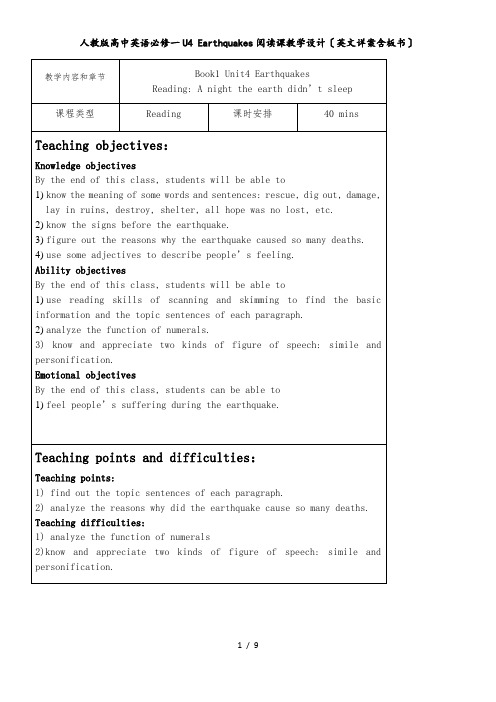
Teaching difficulties:
1) analyze the function of numerals
2)know and appreciate two kinds of figure of speech: simile and personification.
Teaching Procedures
Pre-reading
Activity 1 Brain storming(3mins)
Ss figure out some natural disasters according to their common sense and the pictures.
T:Good morning, class! Do you know any natural disasters? Can you figure out some words about natural disasters?
T: Do you agree with her/him? Does anyone have different opinion?
S5: In 15 terrible seconds, a large city lay in ruins.
人教版高中英语必修1《Unit 4 Earthquakes》教案
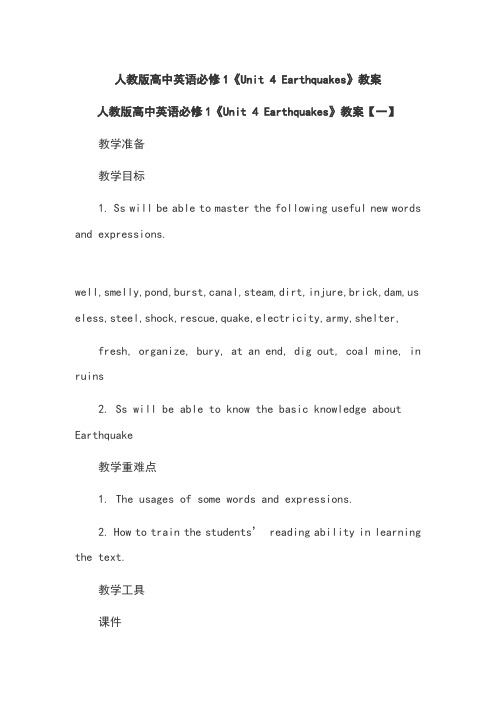
人教版高中英语必修1《Unit 4 Earthquakes》教案人教版高中英语必修1《Unit 4 Earthquakes》教案【一】教学准备教学目标1. Ss will be able to master the following useful new words and expressions.well,smelly,pond,burst,canal,steam,dirt,injure,brick,dam,us eless,steel,shock,rescue,quake,electricity,army,shelter, fresh, organize, bury, at an end, dig out, coal mine, in ruins2. Ss will be able to know the basic knowledge about Earthquake教学重难点1. The usages of some words and expressions.2. How to train the students’ reading ability in learning the text.教学工具课件教学过程Step I lead-inLet students see a short video and answer the questions1.What happened in the video? Earthquakes2.How do you feel seeing the plots(情节)? Students’discussion.Step II Fast reading1. What is the passage mainly about? InTangshan ,earthquakes happened on July 28th 19762. Skim the text and answer the questionsThe type of writing (写作体裁)Narrative writingTopic sentence of Paragraph 1Sentence 1Topic sentence of Paragraph 2Sentence 2Topic sentence of Paragraph 3Sentence 1Topic sentence of Paragraph 4Sentence 1Step III Detailed readingAsk students to read the text carefully and answer the questionsTask1: What were the nature signs of the coming earthquake?(选择)Para 11.Water in well( G )2. Well walls(D )3.Chickens &pigs(F )4 .Mice (A) 5.Fish(E ) 6. Bright lights( B) 7. Water pipes(C )A. Ran out of fieldsB. in the skyC. Cracked and burstD. Deep cracksE. Jumped out of pondsF. Too nervous to eatG. Rose and fell, fell and roseTask 2 Fill in the blanksMain IdeaDetailsDamage caused byearthquakePara 2-3At _____ am, the __________ earthquake of the 20th century began ._______ burst from holes in the ground.Hard hills of the rock became rivers of ____.________ covered the ground like red autumn leaves.Two _______ and most of the bridges fell.The railway tracks were now _________pieces of _______.______ now filled the wells instead of water.Water,food,and ______________ were hard to get.The reconstruction(重建) after the earthquakePara 41. The army _____________2. Workers ____________for survivors.3._____________was taken to the city.Details:1. At 3:42 am, the greatest earthquake of the 20th century began.2. Steam burst from holes in the ground.3. Hard hills of the rock became rivers of dirt.4. Bricks covered the ground like red autumn leaves.5. Two dams and most of the bridges fell.6. The railway tracks were now useless pieces of steel.7. Sand now filled the wells instead of water.8. Water, food, and electricity were hard to get.Step IV consolidation (当堂巩固)Let students fill the blanks according to the passageStrange things were happening in the countryside of northeast Hebei. For three days the water in the village wells kept rising and 1_________(fall). Farmers noticed that the well walls had deep cracks 2___________ them. A smelly gas came out of the cracks. In 3_________farmyards, the chickens and even the pigs were too nervous 4__________(eat). 5_________(mouse) ran out of the fields looking for places 6________(hide). Fish jumped outOf their bowls and ponds. At about 3 am on July 28,1976, some people saw bright lights 7_________ the sky. The sound of planes could 8________(hear) outside the city of Tangshan even 9_________ no planes were in the sky.In the city, the water pipes in some buildings cracked and burst. But the one million people of the city, ________thought little of these events, were asleep as usual that night.1 falling2 in3 the4 to eat5 mice6 to hide 7in 8 be heard 9when 10 who这部分目的是让学生进一步巩固课文的内容。
- 1、下载文档前请自行甄别文档内容的完整性,平台不提供额外的编辑、内容补充、找答案等附加服务。
- 2、"仅部分预览"的文档,不可在线预览部分如存在完整性等问题,可反馈申请退款(可完整预览的文档不适用该条件!)。
- 3、如文档侵犯您的权益,请联系客服反馈,我们会尽快为您处理(人工客服工作时间:9:00-18:30)。
Module 1 Unit 4 EarthquakeReading A night the earth didn’t sleep第一课时Lesson Style: Reading Lesson一、教学分析(一)教学内容分析与初中阶段主要重视英语知识和语法的学习有所不同,高中阶段侧重培养阅读能力,需要学生能把学到的知识灵活运用到对语言、文章的理解中,不断提高分析判断能力、逻辑思维能力和语言运用能力。
本单元的话题是“地震基础知识(basic knowledge about earthquakes)”和“遇到灾难时如何自救以及帮助别人(how to protect oneself and help others in disasters)”。
具体涉及地震的成因、预兆、地震造成的损失、地震时的应急救生以及震后的救援等内容。
本课是本单元的阅读部分,这是是一篇新闻报道,详细介绍了1976年唐山大地震前的预兆、地震造成的城市建筑和人畜损失以及震后人们勇敢面对现实并及时实施抢救和重建工作的情况,从而了解学习到唐山人民勇敢面对自然灾害,积极进行灾后重建的精神。
其次,通过对文章的学习,了解新闻的特点,为后面的写作做准备。
二.学生分析本人所教班级是高一(1),属于比较优秀的学生,由52名同学组成。
虽具备了一定的听说读写能力,但掌握的词汇量较少,阅读能力还有待提高。
因此,本单元侧重训练学生的阅读技巧:略读、细读、总结归纳内容的能力、猜测词义的能力。
三、教学目标1. Make the students know the things about Tangshan Earthquake: Strangesigns before the earthquake, the destruction the earthquake caused and the aid and the rescue from the whole nation.2. Training the students’reading ability: Fast Reading, Close Reading,Summarizing and word-guessing skills.3. Make the students understand: If you can know about the signs beforean earthquake, we will make good preparations before it happens to reduce the loss.四、教学重点:1. Train the students’reading ability2. How to summarize the general idea according to the lines to the passage. 【重点突破】采用任务型语言教学方法,把学生作为教学的主体,以任务为主线,通过听、说、读、写等活动用所学的语言完成所规定的任务。
五、教学难点:How to choose a proper title for a passage.【难点突破】采用探究式的教学方法,引导学生通过观察、分析文章标题,总结出标题的特征。
然后,根据标题的特征为所学文章建议一个恰当的标题。
六、教学方法:Task-based teaching and learning; Inquiry teaching method;Cooperating learning七、教学设备Muti-classroom八、教学过程:I. Warming upPresent two pictures to the students and make them answer some questions. Play the song The Heaven is Your Home《天堂就是你的家》 to rendering the environment.(渲染) the atmosphere.Tangshan Wenchuan1.Can you tell me the names of the two places in the pictures above?2. Where are they?3. What happened to them?Play the video of Tangshan Earthquake and Wenchuan Earthquake.July 28th, 1976 Tangshan, Hebei ProvinceMay 12th, 2008 Wenchuan Area, Sichuan【设计说明】通过展示唐山和汶川的两幅图画,引出关键词“地震”;通过让学生观看唐山地震和汶川地震的有关视频,让学生感知、理解地震是一种可怕的自然灾害,它给我们造成了身体上、心灵上的双重伤害,如果我们能了解并认识地震前的预兆,就能提前做好准备。
)II. Pre-readingPresent a group of pictures to the students which refer to the earthquake. Guess: What may happen before an earthquake?【设计说明】通过展示一组图片,让学生通过观察、讨论预测地震发生前会出现什么样的征兆,培养学生的预测能力,并为阅读做好准备。
III. ReadingWe are going to have an earthquake? Are you ready?(I) Fast ReadingPlease read fast the passage at Page26 and find out the general idea of each paragraph and sum up the general idea of the passage in one sentence. Para1: Before the earthquake strange things began to happen but no one paid attention to them.Para2: The earthquake destroyed the city of Tangshan.Para3: The people were very shocked at the destruction.Para4: The army came to help the survivors, bringing hope for a new life. General idea:The passage is mainly about the terrible earthquake which happened in Tangshan, Hebei province.【设计说明】让学生快速浏览文章A Night The Earth Didn’t Sleep,找出每一段的中心句或用自己的语言概括段意,然后用一句话概括全文的中心大意,旨在培养学生通过略读获取大意的能力以及用自己的语言聚合信息的能力,使他们从整体上来理解这篇文章。
(II) Close readingPlease read the passage again and find out what happened according to the timetable below.Keys: rose, fell, cracks, smelly, gas, ran, jumped, appeared, planes, burst shake, roads, Steam ,turned, gone, killed, injured, second, damage, army, Shelters, supplies【设计说明】要求学生结合文章的内容按照时间顺序列出唐山地震前后所发生的事情,主要培养学生来获取文章细节的能力,加深对文章的理解。
IV. RetellingPlease listen to the tape and fill in the blanks with proper words from the passage, the first letter of each blank given.several days before July28, 1976 many s_____ things happened in Tangshan. They were signs for an e_________ . But people w_____ lived there didn’t think m______ of that. At 3:42 am that day, the earth began to s_____ , which made a large city in r_____ in fifteen terrible minutes. Many people, including workers and doctors, came to r______ those who were t______ under the rubble(废墟). Later that afternoon another big earthquake s______ the city. More people were killed or i______ and more buildings f___ down. Very soon the army sent a lot of soldiers to help, and teams were o_______ to dug out the trapped and b______ the dead. By and by things improved and the city began to b_______ again.Keys: strange, earthquake, who, much, shake, ruins, rescue, trapped, struck, injured, fell, organized, bury, breathe【设计说明】在学生对课文有了整体与细节的理解之后,让他们再听录音,体会文章里表达贴切、内涵丰富的词句,然后根据文章内容及小短文所给的单词的首字母,来复述这篇文章,旨在培养学生用文中的重点词汇归纳文章大意的能力。
V. Further Comprehension1.Read the text carefully again and choose the best answer.1. The title “A night the earth didn’t sleep” means _______.A. the earth was awake all night longB. people on the earth couldn’t fall asleep that nightC. the earth shook like crazy that nightD. animals on the earth would not sleep that night2. Do you think what the characteristics of the title for a passage are____ ?A. GeneralB. TargetedC. Eye-catching3. Please discuss in pairs and suggest another title for the text:________.A. Tangshan’s great challengeB. A night that the earthquake lost its temperC. How Tangshan’s citizens overcome the city’s greatest disasterD. July 28, 1976 saw Tangshan great earthquake【设计说明】标题是文章的“眼睛”,为了让学生全面深刻的领会整篇文章,让他们仔细阅读标题,并紧扣文章内容用英语解释标题所蕴含的意义,旨在培养学生猜测词义的能力以及如何给文章选择一个恰当的标题。
